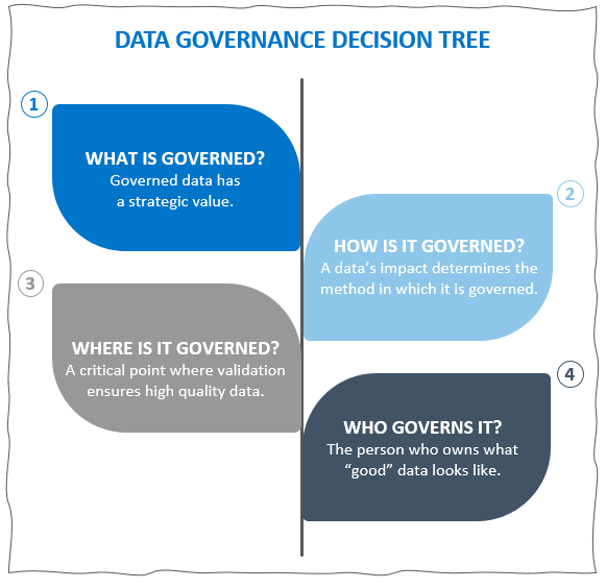We live in a world where rapid change through disruption and innovation is the new normal. In our competitive economy, data is the great equalizer.
Companies that have a data-first mindset will undoubtedly gain a competitive edge.
Understanding the challenges and impacts that bad data has on an organization is the first step in the journey to transform data into a strategic asset. While the right technology is an essential factor in the long-term success of a data program, it is not a key element in beginning the journey; it is far more critical to build a solid foundation.
The Cost of Bad Data
The cost of bad data for companies in the United States alone is astronomical. It is estimated that data, regardless of type, degrades at a pace of just over 5% per month or more than 70% annually. This high rate of decay is caused by three main factors:
- External factors, such as receiving inaccurate or incomplete data (i.e., customer addresses and billing information)
- Poorly defined processes
- User errors; much of our data management remains a manual task.
According to Gartner, the financial impact of our degrading and incomplete data for a company in the United States is estimated at $15 million annually. Imagine what your company could do with an extra $15 million.
When we talk about the high cost of bad data, we often forget the unseen toll it has on our people. It is estimated that knowledge workers spend 50% of their time looking for data, validating data, and correcting data so they can complete core job functions. In an ideal world, what’s the real goal?
As a data purist, I would say, mission one for your employees is to trust your data and spend 100% of their time transforming data into information and information into insights. After all, that is where the true value of data is found. And remember this – the point of a data program is not governance; it is the opportunity to consistently deliver positive business outcomes.
The Roadmap to Success
You would not step onto a football field without a playbook or go on a vacation without an itinerary, and you certainly shouldn’t embark on a data migration project without a strategy.
The goal of a data strategy is to chart a high-level plan that will provide your organization with the roadmap required to leverage data in support of your goals and to gain a competitive advantage ultimately. A data strategy, once defined, will provide clarity of mission, and allow executive leadership a line–of–sight to work being done on behalf of the business.
A strategy alone does not ensure that data is managed and used as an asset. An organization should work to operationalize their data strategy. We recommended that you focus on the process first and then the people. If you do not understand what needs to be done, how will you ensure you have the talent in place to do the work?
A Scalable and Repeatable Process
The 80/20 rule applies to data, just as it applies to other disciplines. While an organization may have anywhere from 10,000 – 30,000 unique data elements across a wide and varied application landscape – it is important to realize that not all data is created equal.
In reality, only several hundred pieces of data impact the strategic priorities of an organization. By addressing these data elements first, on what matters to executives, will a data program gain executive support and long-term funding
At this point, you might be asking yourself, “How do we know what data is the right data to focus on?” The answer is to build a scalable and repeatable process to identify critical data elements. The implementation of a simple 4-step decision tree eliminates personal opinion and introduces meaningful criteria in which to evaluate all data elements.
This process increases cross-functional alignment as each data element is evaluated against the same criteria, providing much-needed context for business users and data stewards alike. The illustration below highlights the four questions imperative in the process of assessing what requires governance and what data does not.
- What is governed depends on what is vital to your organization and can change over time as the business evolves. Some common considerations are compliance, finance, and operations but might also include brand identity and customer experience.
- How we govern differs based on the impact a data element can have. Governing data actively on entry with validation rules versus passively after entry or simply through policies are the various options available to decision-makers.
- Where data is governed is a determination made when an end-to-end process is understood. Understanding the process or processes where a piece of data is used will often reveal the best system and critical point to introduce validation rules.
- Who owns the data can often be a point of contention. However, this process is meant to aid in determining the natural owner. By successfully walking through this 4-step process, ownership typically becomes self-evident.
Implementing this process will create a foundation of trust with your executive team and business users alike. Stakeholders from across your organization will trust that their program is focusing on the right data because they have actively participated in the process of determining what is important and how it is managed.
It’s Still All About the People
With a solid strategy in place and a simple process to identify what is important, it’s time to build a team, the right team. There are almost as many organizational models as there are data programs. Your organization will go through an evolution to find what model best suit your own needs.
There are, however, a couple of things to keep in mind.
Successful data programs rely on collaboration with business users. Data stewards must understand the business they are supporting – they must speak the language in addition to being data experts.
Collaboration means it is critical to identify the right business users to serve as subject matter experts – the go-to business experts the data team can leverage when support is required.
Data teams, like every other team, are not immune to turnover. It is critical for long-term continuity to build a knowledge-based approach to data management and governance.
This means requiring the team to know where to find everything they need and not to know everything themselves. This approach requires a move away from the tribal knowledge that likely exists in your organization, in favor of the development of reference materials that are well understood, easily found, and regularly maintained.
This is Only the Beginning
Over time a data program has the potential to drive accountability and enablement throughout your organization.
It will grow organically, developing the ability to adapt as the business it supports seeks to meet the ever-changing needs of its customers. It is important to realize that defining a strategy, building a process, and assembling the right team are only the first steps in building a lasting program.
These initial steps, when done right, will create a solid foundation for a data program that will garner lasting executive support and drive quantifiable value for your organization.


